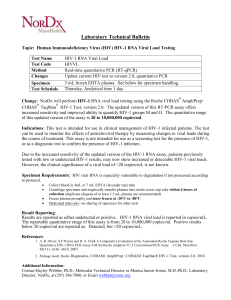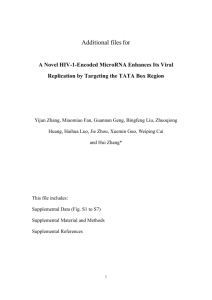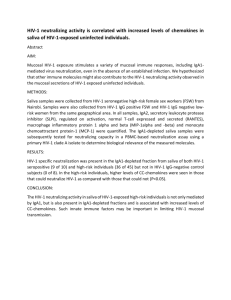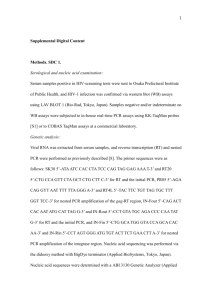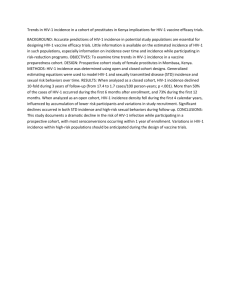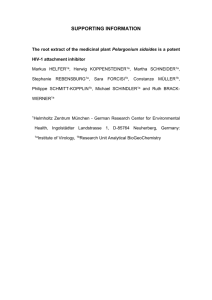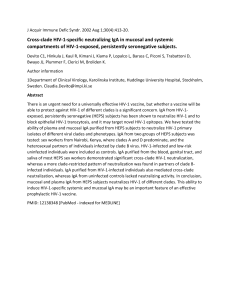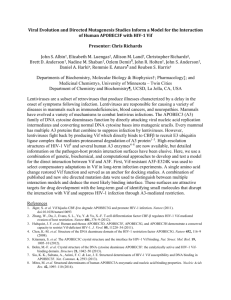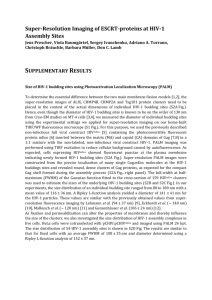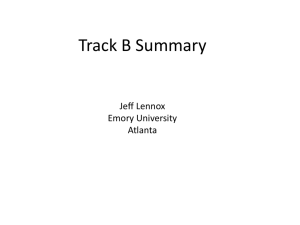August 14, 2012 - University of Virginia
advertisement
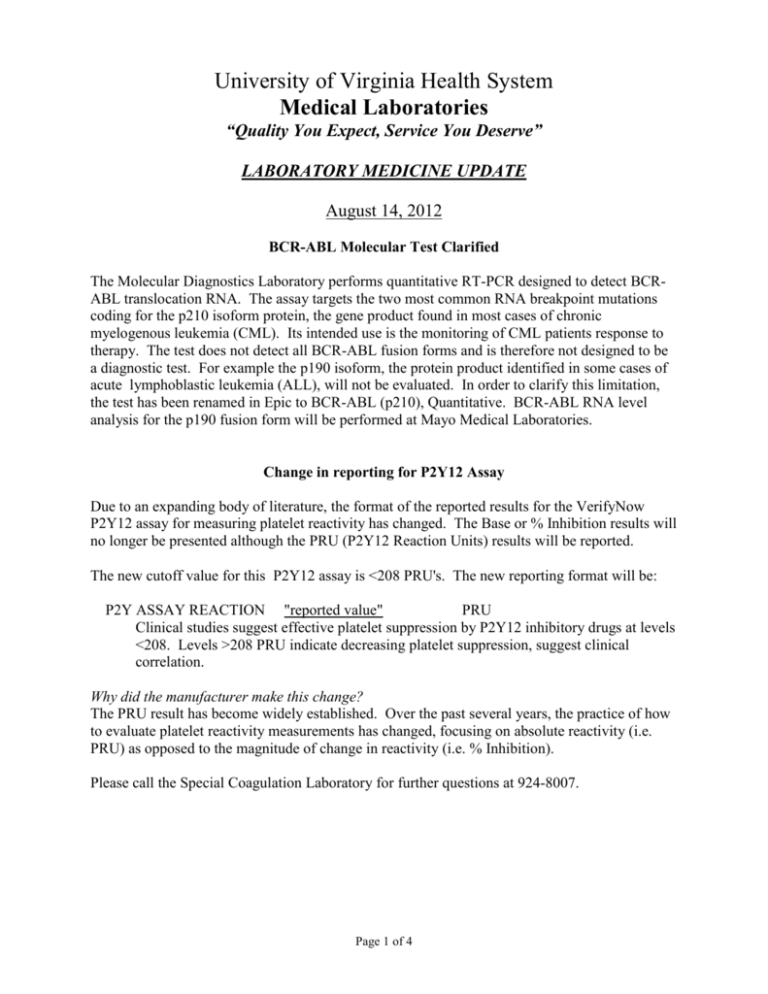
University of Virginia Health System Medical Laboratories “Quality You Expect, Service You Deserve” LABORATORY MEDICINE UPDATE August 14, 2012 BCR-ABL Molecular Test Clarified The Molecular Diagnostics Laboratory performs quantitative RT-PCR designed to detect BCRABL translocation RNA. The assay targets the two most common RNA breakpoint mutations coding for the p210 isoform protein, the gene product found in most cases of chronic myelogenous leukemia (CML). Its intended use is the monitoring of CML patients response to therapy. The test does not detect all BCR-ABL fusion forms and is therefore not designed to be a diagnostic test. For example the p190 isoform, the protein product identified in some cases of acute lymphoblastic leukemia (ALL), will not be evaluated. In order to clarify this limitation, the test has been renamed in Epic to BCR-ABL (p210), Quantitative. BCR-ABL RNA level analysis for the p190 fusion form will be performed at Mayo Medical Laboratories. Change in reporting for P2Y12 Assay Due to an expanding body of literature, the format of the reported results for the VerifyNow P2Y12 assay for measuring platelet reactivity has changed. The Base or % Inhibition results will no longer be presented although the PRU (P2Y12 Reaction Units) results will be reported. The new cutoff value for this P2Y12 assay is <208 PRU's. The new reporting format will be: P2Y ASSAY REACTION "reported value" PRU Clinical studies suggest effective platelet suppression by P2Y12 inhibitory drugs at levels <208. Levels >208 PRU indicate decreasing platelet suppression, suggest clinical correlation. Why did the manufacturer make this change? The PRU result has become widely established. Over the past several years, the practice of how to evaluate platelet reactivity measurements has changed, focusing on absolute reactivity (i.e. PRU) as opposed to the magnitude of change in reactivity (i.e. % Inhibition). Please call the Special Coagulation Laboratory for further questions at 924-8007. Page 1 of 4 Fecal Occult Blood Testing – Change in Methodology The American College of Gastroenterology recommends the use of immunochemical tests (fecal immunochemical test or FIT) for the detection of blood in feces rather than the use of guaiacbased methods. Medical Laboratories will begin offering the immunochemical test (HemoSure®) on or about August 20. This test identifies human hemoglobin specifically so does not have the diet restrictions of the older test. Additionally, a single collection is recommended. Supplies for the new test are available through the Point of Care Testing office. New Referral Lab Test – Microbial Vaginosis/Vaginitis Panel Medical Laboratories is now offering a DNA probe test for detection and identification of Candida species, Gardnerella vaginalis and Trichomonas vaginalis nucleic acid in vaginal fluid specimens from patients with symptoms of vaginitis/vaginosis. Samples are accepted Monday through Friday, with results available in 2 to 3 days. The required collection kit (AFFIRMTM VPIII Ambient Temperature Transport System) is available by calling 434-924-5227. Samples submitted with any other collection device will be rejected. Bacterial vaginosis (BV) is the most common vaginal infection, and accounts for up to 50% of vaginitis/vaginosis cases, depending upon the patient population. While G. vaginalis is no longer thought to be the only etiologic agent of BV, it is still considered to be a primary contributor to infection, which involves an increase in anaerobic bacteria and reduction in normal vaginal flora. BV is considered a risk factor for adverse pregnancy outcome and posthysterectomy cuff cellulitis. BV-associated bacteria in the endometrium may be etiologic agents of endometritis and pelvic inflammatory disease, independent of Gonorrhoeae and Chlamydia infection. Vaginal candidiasis is the second most common form of vaginal infection seen. Approximately half of all adult females will have one or more episodes of vaginal candidiasis in their lifetime, with up to 5% suffering from recurrent and sometimes intractable yeast infection. Trichomoniasis, a non-reportable sexually transmitted disease, has been associated with adverse pregnancy outcomes, post-surgical gynecologic infections, and post-hysterectomy cuff cellulitis. Glucose-6-Phosphate Dehydrogenase (G6PD) Screen Sendout G6PD screen is a test for evaluation of patients with Coombs negative nonspherocytic hemolytic anemia. Due to low volumes the Medical Labs will now send this assay to our reference lab. Updates have been made in the lab LIS as well as EPIC to reflect this change in testing. The reference lab assay can be performed on either a lavender EDTA tube or a yellow ACD tube. The results will be reported as a quantitation in U/g Hb (hemoglobin) using a Kinetic Spectrophotometric assay. The reference interval for patients >12 months of age is 8.8 – 13.4 U/g Hb. Reminder for Timed Urine Collections It is important for the laboratory to have accurate date and time for timed urine collections. This is particularly critical if more than one timed urine is being collected and submitted on the same patient for example, two 24-hour urines one “on-drug” and one not. Thank you for your assistance. Page 2 of 4 To Ice or Not? A reminder that specimens submitted to Medical Laboratories for ammonia should be submitted on ice. Specimens submitted for lactic acid do not when they are collected in gray top tubes nor do specimens for ionized calcium, unless submitting as part of a blood gas profile. Please remember that “on ice” means the specimen container should be placed in a bag separate from the ice. T-Uptake, Thyroid-Resin Uptake, T3 Uptake, T3 Resin Uptake The above terms all refer to tests used to estimate the total binding capacity of human serum or plasma for thyroid hormones. These tests have largely been replaced by tests that directly report the free, unbound concentrations of thyroxine (free T4) and T3 (free T3). The “T-Uptake” test available at UVA is a variant of the older “T3-Resin Uptake Test,” and its results are inverse to those of the older test. Its reference interval (normal range) is 0.69 – 1.41 Units. These T-Uptake results are dimensionless. Note that this test is different from tests that report results in %. The T-Uptake assays are used to normalize the Total T4 concentrations for variations in serum thyroxine binding proteins. This is done by use of the equation below to calculate the Free Thyroxine Index (FTI). FTI = (Total T4) / (T-Uptake Units) The manufacturer’s recommended reference interval for FTI is 5.06 – 9.42 μg/dL. Note that the FTI may not fully correct the Total T4 when abnormalities of binding protein concentration are extreme. Reference intervals for women in the first and second trimesters of pregnancy are available for free T4, TSH, FTI and other thyroid hormone tests as measured by the assays used at UVA (1,2). In current endocrinology practice, the FTI has largely been replaced by the measured free T4. References 1. La'ulu SL, Roberts WL. Ethnic differences in first-trimester thyroid reference intervals. Clin Chem. 2011 Jun;57(6):913-5. 2. La'ulu SL, Roberts WL. Second-trimester reference intervals for thyroid tests: the role of ethnicity. Clin Chem. 2007 Sep;53(9):1658-64. Page 3 of 4 Extended Dynamic Range for Quantitative HIV-1 RNA As of August 9, 2012, Clinical Microbiology and Molecular Diagnostics has transitioned to the COBAS® AmpliPrep/COBAS® TaqMan® HIV-1 Test, version 2.0, an in vitro nucleic acid amplification test for the quantification of Human Immunodeficiency Virus Type 1 (HIV-1) RNA in human plasma. This test expands coverage by targeting two highly conserved regions of the HIV-1 genome to compensate for the possibility of mutations or mismatches. As with v1.0 of this test, COBAS® AmpliPrep/COBAS® TaqMan® HIV-1 Test, v2.0 is not intended for use as a screening test for the presence of HIV-1 in blood or blood products or as a diagnostic test to confirm the presence of HIV-1 infection. Notable changes with v2.0 include: Quantifies clinically significant HIV-1 groups and subtypes with full subtype coverage and quantification of HIV-1 groups O and M Quantifies HIV-1 RNA from 20 - 10,000,000 copies/mL, providing a lower limit of detection (LOD) with 100% specificity at 20 copies/mL (One copy of HIV-1 RNA is equivalent to 1.7 ± 0.1 International Units (IU) based on the WHO 1st International Standard for HIV-1 RNA for Nucleic Acid-Based Techniques). HIV Genotyping and Resistance Reporting New guidelines for HIV antiviral drug resistance markers have been released by The Consensus Panel, a panel of international experts on HIV resistance mechanisms. The correlation of Protease and Reverse Transcriptase sequences to antiretroviral drug resistance is based on interpretation of in vitro and in vivo phenotypic and virologic response data by this group and includes both primary and secondary mutations detected by the Siemens TRUGENE HIV-1 Genotyping Test. This is the most current interpretive algorithm for assessing the clinical implications of HIV-1 resistance mutations, and will be applied to the Molecular Diagnostic Laboratory HIV-1 resistance reports beginning August 9, 2012. Notable changes in the new guidelines include: Resistance interpretation results added for Reverse Transcriptase Inhibitor Rilpivirine (RPV). Results for this drug will now appear on the resistance report. Mutations L74V alone and Y115F alone have been upgraded to full Resistance for the Reverse Transcriptase Inhibitor Abacavir (ABC). E138K alone has been upgraded to full Resistance for the Reverse Transcriptase Inhibitor Etravirine (ETR). G48M is now considered in resistance interpretations for Protease Inhibitors Atazanavir (ATV), Atazanavir + Ritonavir (ATV/r), Lopinavir + Ritonavir (LPV/r), and Saquinavir + Ritonavir (SQV/r). E92Q alone and G118R alone are now considered for Possible Resistance to the Integrase Inhibitor Raltegravir. Note: This information is provided as a convenience only. The Integrase Inhibitor region is not covered by the TRUGENE HIV-1 Resistance Interpretation Report and results of this drug will not appear on the report. Page 4 of 4
